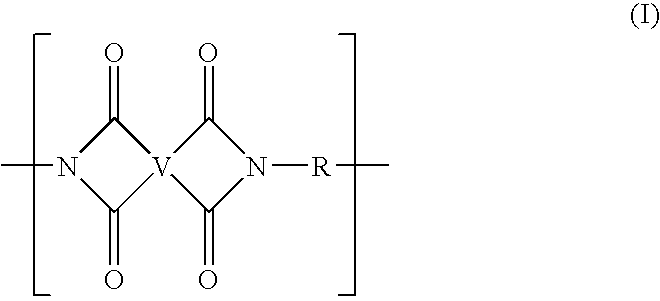Preparation of polyimide polymers
- Summary
- Abstract
- Description
- Claims
- Application Information
AI Technical Summary
Benefits of technology
Problems solved by technology
Method used
Image
Examples
example 2
[0044] 2,2-Bis(4-(3,4-dicarboxyphenoxy)phenyl)propane dianhydride (341.25 kg, 0.65 kmole), p-phenylene diamine (70.9 kg, 0.65 kmole), and sodium phenyl phosphinate (125 grams) are dissolved in o-dichlorobenzene (2500 liters). The solution is heated to 180.degree. C. under a nitrogen purge for one hour. The manageable slurry (2500 liters) is transferred and cooled to 50.degree. C. in a hold tank and has a solids content of about 11 wt %. Charges (portions of the slurry) (225 liter) were centrifuged for 2.5 hrs. The size of the charge is dependent upon the capacity of the centrifuge. The resulting wet-powder (70 kg) is transferred to a dryer set at 140-160.degree. C. and under a vacuum set at 60 millimeters Hg for 3.5 hours. The resulting coarse powders are collected and transferred to a jet mill and milled to a reduced mean particle size. The reduced solids content decreases the milling time required to obtain a desired particle size.
[0045] As can be seen by the preceding examples it...
PUM
| Property | Measurement | Unit |
|---|---|---|
| Percent by mass | aaaaa | aaaaa |
| Angle | aaaaa | aaaaa |
| Percent by mass | aaaaa | aaaaa |
Abstract
Description
Claims
Application Information
 Login to View More
Login to View More - R&D
- Intellectual Property
- Life Sciences
- Materials
- Tech Scout
- Unparalleled Data Quality
- Higher Quality Content
- 60% Fewer Hallucinations
Browse by: Latest US Patents, China's latest patents, Technical Efficacy Thesaurus, Application Domain, Technology Topic, Popular Technical Reports.
© 2025 PatSnap. All rights reserved.Legal|Privacy policy|Modern Slavery Act Transparency Statement|Sitemap|About US| Contact US: help@patsnap.com



